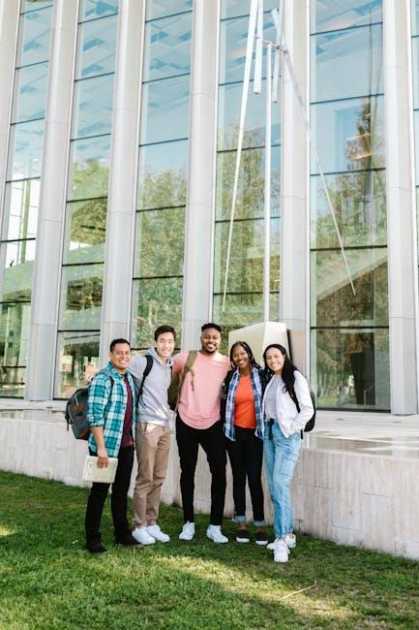Navigating the complexities of obtaining a student visa can feel like traversing a labyrinth, filled with potential pitfalls that can lead to rejection. For many aspiring international students, the dream of studying abroad is not merely an academic pursuit; it’s a pathway to cultural enrichment, personal growth, and future career opportunities. However, for some, that dream is abruptly thwarted at the visa submission stage. understanding the nuances of the application process is crucial, as even minor oversights can result in denial. In this article, we will explore the five common reasons why student visas get rejected and provide practical tips on how to avoid thes pitfalls. By being informed and prepared, you can enhance your chances of transforming your international education aspirations into reality.
Understanding the crucial Role of Documentation in Visa Applications
Documentation serves as the backbone of visa applications,particularly for student visas,where clarity and accuracy are paramount. A well-organized application bolstered by thorough documentation can considerably enhance your chances of approval. It’s essential to provide all required documents right from your acceptance letter, proof of financial resources, to any supporting evidence demonstrating your ties to your home country. Missing or incomplete documentation can lead to unneeded delays or outright rejections. Thus, it’s beneficial to keep track of each required item and ensure all documents are up-to-date and verifiable.
Moreover,the manner in which you present your documentation can impact the decision-making process.A simple checklist can be an effective tool to keep you on track. Consider organizing your documents in a logical order, perhaps categorizing them into sections such as personal identification, financial proof, and academic letters. This not only assist the reviewing officer in assessing your application swiftly but also reflects your preparedness and professionalism. Below is an example of what your documentation checklist might look like:
| Document Type | Required Status |
|---|---|
| Acceptance letter | Confirmed |
| Financial Documents | Current |
| Passport Copy | Valid |
| Suggestion Letters | Included |
| Visa Application Form | Complete |
Demystifying Financial Requirements for Aspiring International Students
understanding the financial requirements for obtaining a student visa is essential for any aspiring international student. Many candidates underestimate how crucial these financial proofs are, leading to potential visa rejections. To bolster your application, it is vital to demonstrate sufficient funds to cover tuition, living expenses, and other related costs.This can typically be shown through bank statements, sponsorship letters, or scholarship notifications. Remember, the amount needed can vary based on the country and institution; hence, familiarizing yourself with these specifics is crucial.
additionally, having a clear financial plan underscores your commitment and seriousness towards your studies. Consider creating a budget outline that includes tuition fees, housing, food, and transportation to present a comprehensive picture of your financial stability. A simple table can help illustrate potential costs and savings,making it easier for visa officers to process your application. Here’s a snapshot to guide your preparation:
| Expense Category | Estimated Monthly Cost |
|---|---|
| Tuition fees | Varies by program |
| Housing | $500 – $1,500 |
| Food | $200 – $400 |
| Transportation | $100 – $200 |
By presenting a well-rounded financial profile alongside your visa application, you can significantly enhance your likelihood of approval. Be sure to convey not only your current financial situation but also any potential sources of income or scholarships that can contribute to your education abroad. This proactive approach can effectively mitigate concerns about your financial capacity and demonstrate that you are a responsible and prepared candidate.
Crafting a convincing Statement of Purpose to strengthen Your Case
when applying for a student visa, your statement of purpose (SOP) serves as a crucial piece of the puzzle that can significantly strengthen your case. It’s not just a formality; it’s an possibility to present yourself compellingly to visa officers. Clarity and passion need to shine through your writing, as this will convey your genuine intent to study abroad. Focus on articulating your academic goals and how they align with the educational opportunities in your chosen country. A well-crafted SOP should address the following points:
- Your motivations for choosing your specific course and institution.
- Your career aspirations and how the program will help you achieve them.
- Evidence of financial stability to support your studies and living expenses.
- Your ties to your home country that demonstrate your intent to return after studying.
Additionally, it’s essential to avoid ambiguities that can lead to misunderstandings. Clear and concise language will reinforce your credibility. Consider including relevant experiences, such as internships or volunteer work, that pertain to your field of study. Presenting this details in a structured way, like through a brief table or bullet points, can enhance readability. Here’s an example of how you can showcase your experiences effectively:
| Experience | Duration | Relevance |
|---|---|---|
| Internship at XYZ Company | 6 months | Gained practical skills in marketing |
| Volunteer at Local NGO | 1 year | Developed dialog and teamwork abilities |
Navigating the Interview Process: Tips for Making a Positive Impression
Preparing for an interview can be daunting,but understanding how to navigate this crucial step can significantly enhance your chances of success. Start by researching the institution or organization you are interviewing with, which will allow you to tailor your answers and demonstrate your genuine interest. Make sure you practice common interview questions and prepare your own insightful inquiries about the program or position. Remember to highlight your academic achievements and relevant experiences while presenting them in a way that aligns with the goals and values of the institution.
During the interview, maintaining a positive and professional demeanor is essential. Some key strategies to achieve this include:
- Arrive Early: Being punctual shows respect for the interviewer’s time.
- Dress Appropriately: Your attire should reflect the formality of the interview habitat.
- Practice Active Listening: Engage with the interviewer by nodding and responding thoughtfully to their questions.
- follow Up: Sending a thank-you email afterward can leave a lasting impression.
Q&A
Q&A:
Q1: What are some of the most common reasons for student visa rejections?
A1: There are several underlying reasons that can lead to a student visa rejection. The five most prevalent ones include insufficient financial proof, lack of academic preparedness, discrepancies in application documents, insufficient ties to the home country, and failure to demonstrate a clear study plan.
Q2: How does insufficient financial proof impact a student visa application?
A2: Insufficient financial proof raises red flags for visa officers regarding your ability to support yourself while studying abroad. To avoid this, ensure you provide clear documentation—like bank statements, scholarship letters, or sponsorship letters—that reliably demonstrates your financial capacity to cover tuition, living expenses, and any other costs for the duration of your studies.
Q3: Can you explain what “lack of academic preparedness” means?
A3: Lack of academic preparedness refers to failing to show that you have the right qualifications and motivation to succeed in the chosen study program. This could include not having the required transcripts, standardized test scores, or admission letters. To tackle this, research your target institution’s requirements thoroughly and include all necessary academic documents with your application.
Q4: What types of discrepancies in application documents could lead to rejection?
A4: Discrepancies might include mismatched names,differing dates,or conflicting statements between your visa application and other official documents. Such inconsistencies create doubt about the authenticity of your application. Avoid this by meticulously checking all documents for accuracy and ensuring that they align perfectly with each other.
Q5: Why are ties to the home country significant in the student visa process?
A5: Visa officers want to see that you’ll return to your home country after your studies, which is why establishing strong ties is essential. These ties could be family, job prospects, or property ownership. Demonstrating this in your visa application—such as through letters from employers or proof of family connections—can help convince them of your intention to return.
Q6: How important is a clear study plan for a student visa application?
A6: A clear study plan is crucial; it shows that you have thought carefully about your educational journey and how it aligns with your career goals. To avoid rejection, be prepared to articulate why you’ve chosen your specific program, how it fits into your future plans, and what you hope to achieve during your studies. This clarity can make a strong impression on visa officers.
Q7: are there any tips to enhance the likelihood of a successful student visa application?
A7: Absolutely! Aside from addressing the common pitfalls mentioned, ensure you thoroughly research visa requirements specific to your destination country, seek guidance from those who have successfully navigated the process, and consider working with educational consultants familiar with immigration laws. Being well-prepared can make all the difference in securing that student visa.
Q8: What resources are available for students feeling overwhelmed by the visa application process?
A8: Many universities offer dedicated international student offices that provide assistance with the visa process. Additionally, government immigration websites often outline the requirements and guidelines clearly. There are also numerous forums and social media groups where students share their experiences and advice, making them invaluable resources for support and information.
To Conclude
in the journey of pursuing education abroad,navigating the intricate world of student visas can often feel like a daunting task. However, understanding the common pitfalls can equip you with the knowledge needed to enhance your application. By being aware of the key reasons for rejection—such as incomplete documentation, lack of financial proof, or insufficient ties to your home country—you can take proactive steps to fortify your case.
As you embark on this exciting chapter of your life, remember that preparation is your greatest ally. Diligently gather the required documents, meticulously verify your financial standing, and articulate your intentions with clarity and honesty. In turn, you’ll be well on your way to turning your dreams of studying abroad into a reality.
the path to securing a student visa might be fraught with challenges, but armed with the right information and strategies, you can significantly improve your chances for success. So, as you prepare to take the next step in your educational adventure, approach your application with confidence and diligence—your future awaits!


















